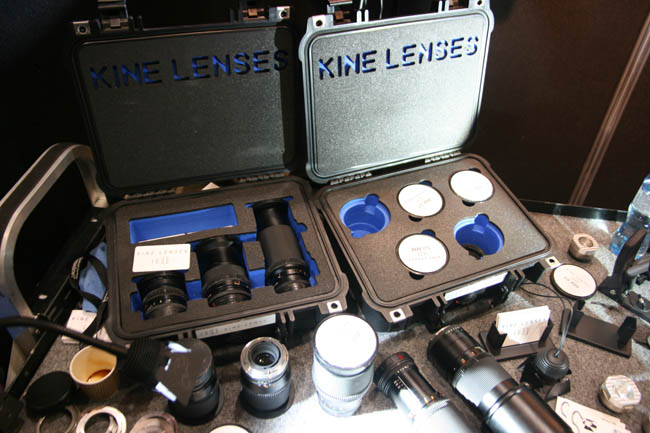
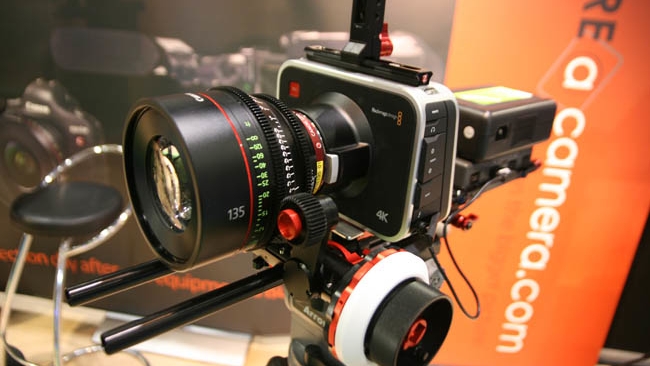 Blackmagic Production Camera
Blackmagic Production Camera
It may be a smaller show but it's more intimate and there are some hidden gems if you look hard
BVE (Broadcast Video Expo) is fun in the sense that it's a movie industry trade show, but in England, so it's smaller and full of esoteric things, and there's tea and cakes. But I digress.
One particularly fun bit of esoterica was a collection of reworked Zeiss stills lenses. Having realised that cheap cameras still require lenses, Kine Lenses are offering nicely-refurbished Zeiss stills glass which nicely complements the ever-broadening range of freshly-minted movie primes that Samyang are now offering in very aggressively-priced kits. Outfitted with geared drives for focus and declicked irises, Kine Lenses' products exist in a price bracket somewhere above Samyang but well below the interstellar costliness of the likes of Zeiss and Cooke, and as such make a lot of sense in a world where big chips are becoming as common as potato chips.
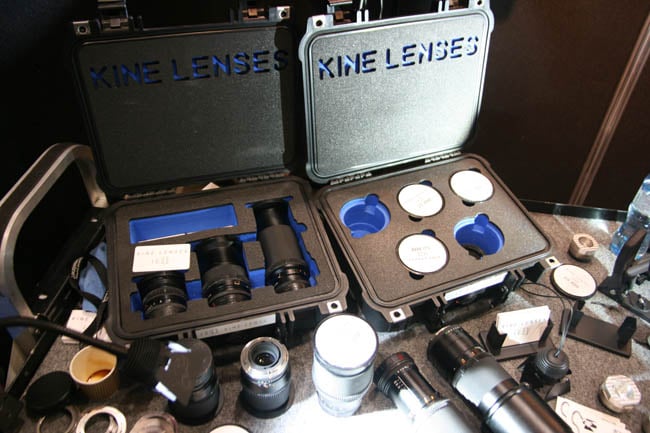
Blind Spot Gear
Sharing their booth, and several personnel, was a nice little soon-to-be Kickstarter project run by Blind Spot Gear (www.blindspotgear.com) aiming to put into manufacture the Scorpion light, a nice little ten-watt LED with barn doors on a gooseneck mount. Anyone who's switched on a modern LED-based flashlight and reacted with raised eyebrows at the amount of light produced will have seen something like this coming, but it's nicely done and I mention it here because innovation and entrepreneurship at the individual level needs to be encouraged. They're proposing a kit of four with various accessories for £765, or £995 with battery power options. I think this might be fractionally ambitious for 40W of LED light which doesn't talk about colour rendering at any point, but that's probably the price of not making it in China.
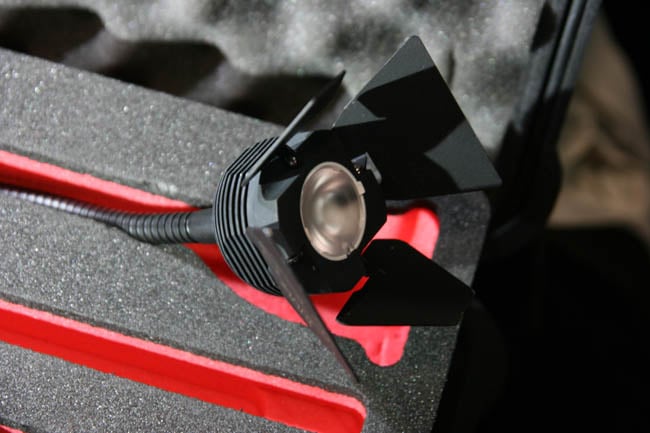
People who rent camera equipment in the UK and aren't in London might well be aware of hireacamera.com, a place which has for some time been making it possible to rent gear without having to directly confront the twin evils of insurance and collection. While they're happy to take evidence of a client's production insurance (which is probably the cheapest way to do it), they will sell you insurance, and they'll also deliver. It's a very convenient arrangement, probably no more expensive than the train ride into London (although those are expensive enough), and easy to use. The problem until recently has been that they have had camera bodies but less by way of accessorisation. At BVE, though, they showed a Blackmagic 4K Production Camera outfitted with rods, battery mount and follow focus, and announced that they are now offering rigging and accessories. On one hand, this does suffer from the practical issue that there is an almost infinite variety of rods, clamps, mounts, adaptors, shafts, gears and plates that could be required by a particular configuration, and so we must hope that the company's inventory has been generously stocked. Offsetting the very real issues of compatibility and fit, however, is the company's pledge that all camera packages will be fully assembled to check that it all goes together properly before being split back down into the cases for shipping. After specifying an outfit over the phone, this will be a reassuring precaution.
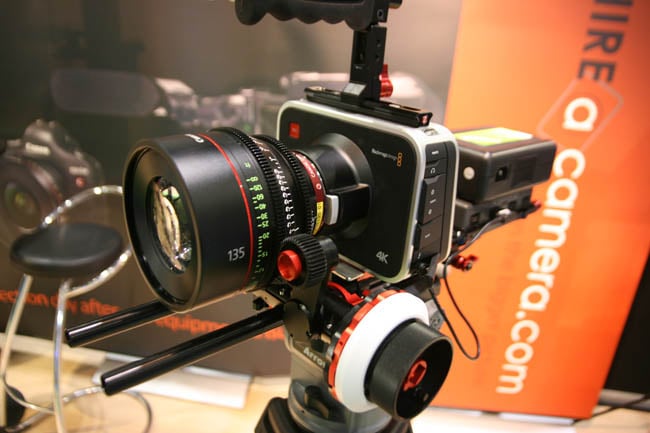
Camdec
To return to a theme of small, independent manufacturers, we could wander down a side aisle and find the small booth of Camdec, who build a shoulder rig intended for cameras such as the Sony FS range and DSLRs. These typically frustrate people used to betacam-style ENG camera layout – what am I saying, they frustrate everyone – and there is of course a huge amount of stuff available to solve this problem. Camdec's approach is a sliding dovetail system with two mounts on top and a shoulder pad below, with the option to mount a set of 15mm rods on the front. This is probably a stiffer, more robust approach than those which rely on 15mm rods and various adaptors and accessories to support the entire rig, but that's also a downside, because there's now a huge range of 15mm rod accessories available. I can't help feeling that Camdec might need to do perhaps one more round of refinements, particularly to add compatibility with Sony VCT-14U quick release plates which are widely used to attach shoulder-mounted cameras to bits of grippery.
Training
Like a lot of people, I get calls from young people eager to work in film and TV (which is fine, although I'm regrettably not usually able to help). In this vein, while I won't mention any names, BVE 2014 did include significant representation of UK training entities. Many of the courses offered by these colleges and universities are accredited by Skillset, which implies, apart from quality, the idea that there might actually be jobs available for people with that particular qualification. The idea here is to avoid having people train for roles that aren't really needed, with lack of appropriate training a plaint common to everyone from small businesses up to the CBI. The problem is that there's nothing stopping anyone offering a course without accreditation, with the result that the UK, like most countries where filmmaking is rather a fringe concern, has rather more degree-holding and heavily indebted film directors than it can comfortably employ. Training is useful and important, of course, but there may be no good solution to this other than to carefully evaluate which creative training – at any level – is most likely to lead to satisfying employment. If I can encourage people to do that in this article, then I'm happy.
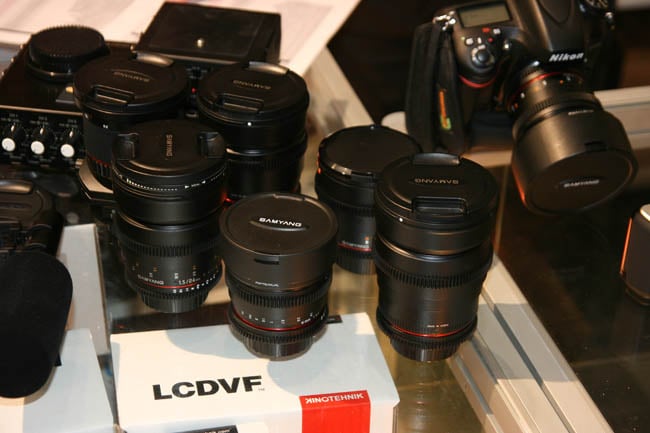
To round off on a high note, I would ordinarily talk about the really rather lovely results from the Panasonic GH4, shown a BVE in one of its first public outings, but someone else has already done that in another article. 4K, it seems, is destined to be an official Thing, even if we treat it solely as a mastering format and thereby become better able to put out really good-looking HD. Panasonic's offering always seemed likely to be the price-performance sweet spot for reasonable-quality 4K images, and their showing at BVE did nothing to dispel this idea. Their decision to release information on the 4K varicam (which this sentence previously predicted would occur at NAB) one day after the show is was odd, though.
Of course what we might be seeing here is the technological singularity of camera development, wherein sensors of both high resolution and high quality in other respects are starting to become, if not trivial, at least reasonably easy to make. Production audio reached this point some time ago, and if camera goes the same way – as it eventually must – then we're going to have no excuses anymore.
Tags: Business


Comments